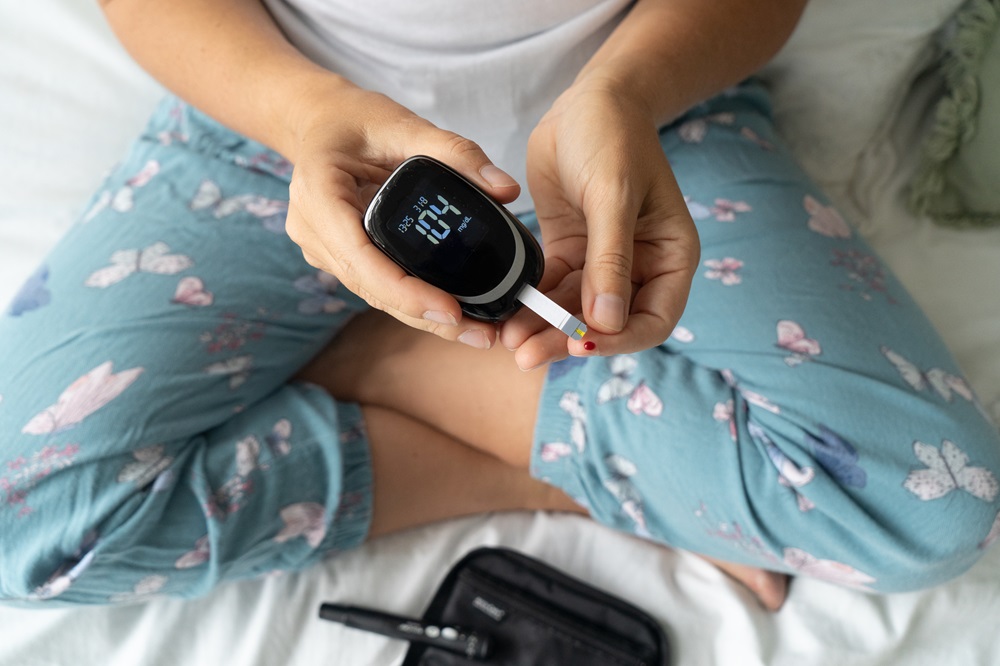A condition characterized by elevated blood glucose levels that do not meet the criteria for type 2 diabetes.
It increases the risk of cardiovascular disease and type 2 diabetes and is associated with the presence of obesity (especially abdominal or visceral obesity), dyslipidemia, and high blood pressure.
What are the main signs and symptoms of prediabetes?
Prediabetes is an asymptomatic condition.
Signs, or indications that an individual should undergo testing to determine whether they have prediabetes, include overweight or obesity in combination with at least one of the following risk factors: family history of diabetes, high-risk race/ethnicity (i.e., Black, Latino/Hispanic, Native American, Asian American, Pacific Islander), history of gestational diabetes, polycystic ovary syndrome, high blood pressure, low high-density lipoprotein cholesterol (HDL-C) levels, or elevated triglycerides.
Universal screening irrespective of the presence of risk factors is recommended for adults at least 35 years old.
If initial screening results meet the criteria for prediabetes, it is recommended to repeat screenings yearly.
If the results are normal, it is recommended to repeat screenings at least every three years, or sooner if symptoms of diabetes (e.g., excessive thirst) or other risk factors (e.g., hypertension) develop.
How is prediabetes diagnosed?
Prediabetes is diagnosed based on either fasting plasma glucose, 2-hour plasma glucose during a 75-gram oral glucose tolerance test (OGTT), or HbA1c.
According to the American Diabetes Association, an individual should be diagnosed with prediabetes if they have one of the following:
- Fasting glucose of 100–125 mg/dL (5.6–6.9 mmol/L)
- 2-hour glucose during an OGTT of 140–199 mg/dL (7.8–11.0 mmol/L)
- HbA1c of 5.7%–6.4%
Notably, the World Health Organization defines the lower limit for impaired fasting glucose as 110 mg/dL (6.1 mmol/L).
Evidence suggests that an OGTT is the most sensitive diagnostic test for prediabetes, and reliance on either fasting glucose or HbA1c alone may result in significant underdiagnosis of prediabetes.
What are some of the main medical treatments for prediabetes?
Lifestyle intervention (i.e., weight loss, exercise, healthy eating, reduction or cessation of alcohol intake) is the cornerstone of prediabetes treatment, but metformin is considered the first-line pharmacological intervention.
It’s recommended that metformin be added for people with prediabetes who have a BMI of at least 35, higher glucose levels (e.g., fasting glucose ≥ 110 mg/dL, HbA1c ≥ 6.0%), and/or a history of gestational diabetes.
Metformin may also be considered in cases where lifestyle intervention is ineffective.
Weight-loss drugs (e.g., semaglutide) are another increasingly popular option to enhance the efficacy of lifestyle intervention.
How could diet affect prediabetes?
A hypocaloric diet is a powerful intervention for people with prediabetes and overweight or obesity, as achieving and maintaining significant weight loss (at least 5% of initial body weight) can prevent or delay the development of type 2 diabetes.
In the context of significant weight loss, there does not appear to be an ideal macronutrient distribution, so the diet should be customized to the individual’s dietary preferences and metabolic goals to maximize adherence.
Plant-based dietary patterns that emphasize the consumption of whole grains, legumes, nuts, fruits, and vegetables may be particularly beneficial for reducing the risk of type 2 diabetes.
How does a high-protein diet affect people with prediabetes?
Have any supplements been studied for prediabetes?
A wide variety of supplements hypothesized to improve glycemic control have been studied in people with prediabetes, including zinc, vitamin D, cinnamon, berberine, curcumin, probiotics, panax ginseng, vitamin K, omega-3 fatty acids, aloe vera, and mulberry leaf extract.
Are there any other treatments for prediabetes?
Physical activity is pivotal for preventing or delaying the development of type 2 diabetes.
At least 150 minutes of moderate-intensity physical activity (e.g., brisk walking) plus two resistance exercise sessions should be performed each week to promote further improvements in insulin sensitivity.
Additionally, breaking up periods of sitting with standing or walking can improve postprandial (after-meal) glucose levels.
Tobacco cessation is also recommended.
What causes prediabetes?
The causes of prediabetes overlap with those of type 2 diabetes, as the physiological defects that underlie the latter — insulin resistance and loss of pancreatic beta-cell (cells that produce and secrete insulin) function — are also present in prediabetes, albeit to a lesser extent than in type 2 diabetes.
The causes of prediabetes are multifactorial and are influenced by genetic predisposition and environment. However, excess energy intake and sedentary behavior, leading to the accumulation of more visceral fat than the individual can tolerate, are primarily responsible for the hyperglycemia that defines prediabetes.

